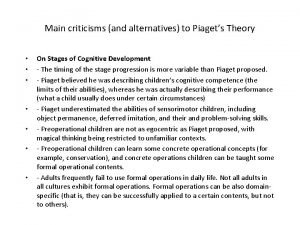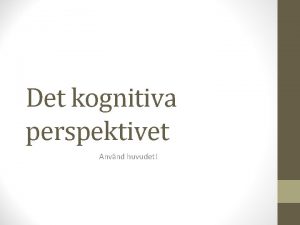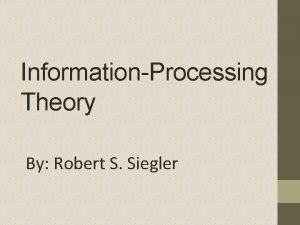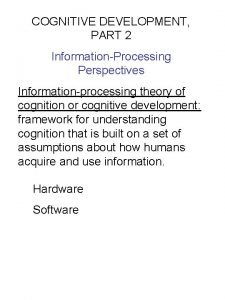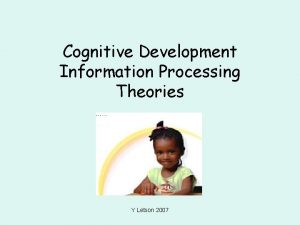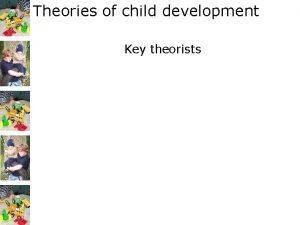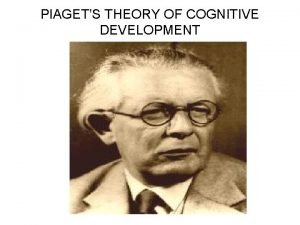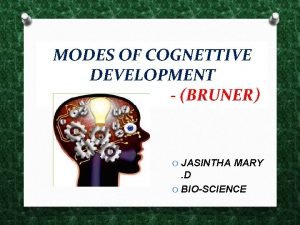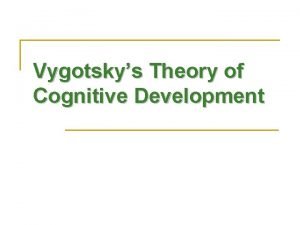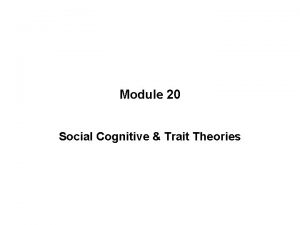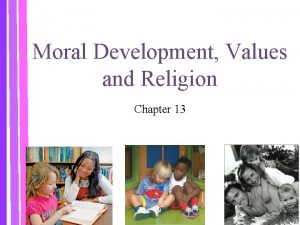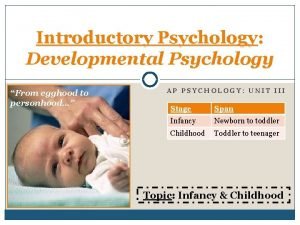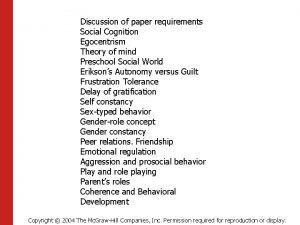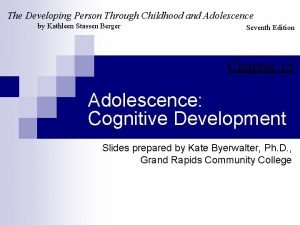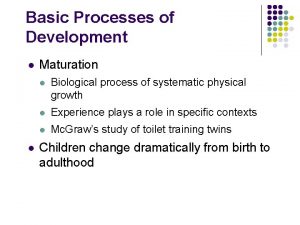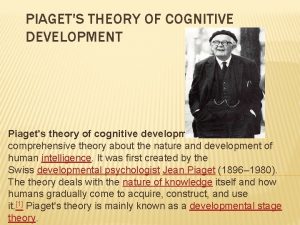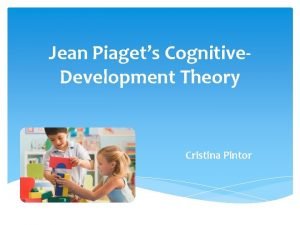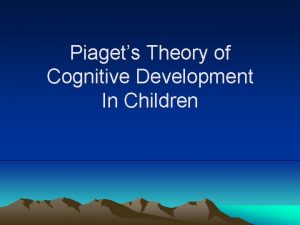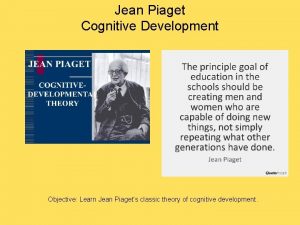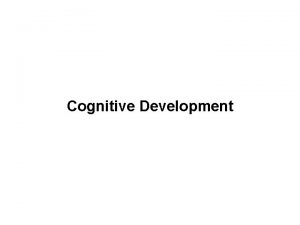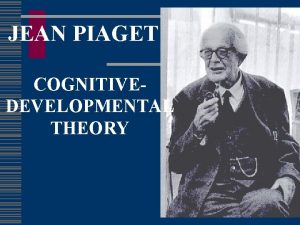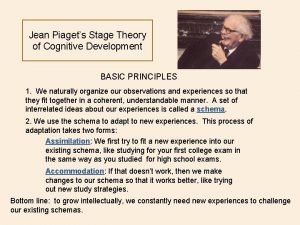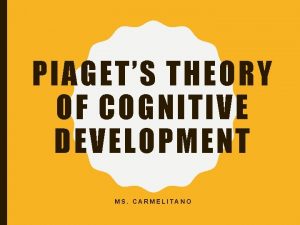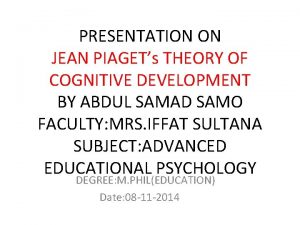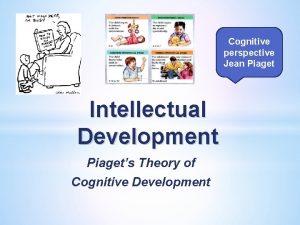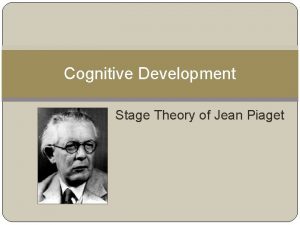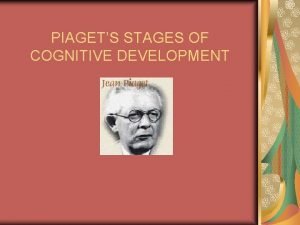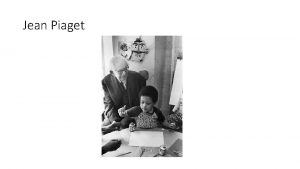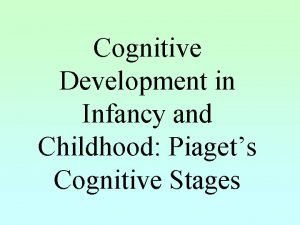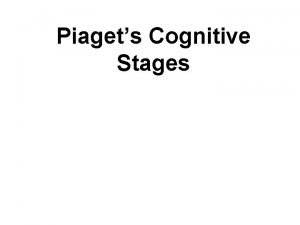Jean Piagets Theory of Cognitive Development Egocentrism and























- Slides: 23

Jean Piaget’s Theory of Cognitive Development: Egocentrism and the Three-Mountain Task By: Martin Lopez

Jean Piaget • Born August 9, 1986 in Neuchatel, Switzerland • At 10, published first article on sparrows • At 15, he decided to focus his work towards biological explanation of knowledge • At 18, received B. A. from University of Neuchatel • At 21, earned a doctorate in the natural sciences

Jean Piaget • By 21, he had published 25 professional papers (mostly on mollusks) • At 23, he researched children psychology • By 30, Piaget was famous for his works in psychology • Has honorary degrees from Harvard, Columbia, University of Brussels, the Sorbonne, and Brazil • Jean Piaget is NOT a maturationist!!!

Overview of Theory • Stage theory • Children pass through these four stages in an invariant sequence • Children use biological tendencies: assimilation, accommodations, adaptation, and organization • Development is an active construction process • It is through children’s activities is where they build their cognitive structures

Nature vs. Nurture • Piaget believed that nature and nurture interact to yield cognitive development • Adaptation: The tendency to respond to the demands of the environment to meet one’s goals • Organization: The tendency to integrate particular observations into coherent knowledge


Preoperational Stage • Takes place from ages 2 to 7 • Child’s mind takes on symbols (including images and words) • Development of egocentrism, centration, and inability to follow transformations • Development of language, child use words as symbols • Children fail to conserve different objects • Transductive reasoning, shifting from particular to particular, appears

Concrete Operations Stage • Takes place from ages 7 to 11 • Characterized by the appropriate use of logic. • Important processes during this stage are: seriation, classification, reversibility, conservation, and elimination of egocentrism • Only solve problems that apply to actual (concrete) objects or events

Egocentrism • It is the inability to distinguish one’s own perspective from that of others. • Encourages centration, tendency of the child to focus attention on one aspect of situation and ignore all others. • Found primarily in the preoperational stage (2 -7 yrs).

Three-Mountain Task

Guiding Questions • Will children in the same stage of development have the same perspective as their peers? • Will there be a difference in stage development between older children and younger children? • Can a child identify an image from the perspective of another person or thing? • Can a child identify their own perspective of the image? • Does a child’s egocentrism continue throughout the different development stages or does should it end at a particular stage of development?

Participants • 17 1 st graders (6 -7 yrs) from Holy Family of Nazareth Elementary School-Irving, TX • 23 4 th graders (9 -11 yrs) from Lavaland Elementary School- Albuquerque, NM

Procedure • The children were sat down at one end of the table containing four chairs on each side of the table. There were three different sized squares on top the table. Then each child was given a piece of paper with four different images of the squares. Then I sat next to the child and asked them to circle the view that was in front of me, or my view of the squares. • I continued moving around the table counterclockwise until all of the three images were selected by the child.

Hypothesis • The preoperational child will not be able to identify all of the images from that of another person’s perspective, but they will be able to pick their own view. • The older children tested (9 -10 yrs) will be able to identify all of the images and their own view

NAME___________________ AGE_________________ View 1 View 3 View 2 View 4 (Child’s View)

Data Collection Tool • The children’s egocentrism will be examined by using a one-point scale for each correct image identified. • The child will receive an automatic one point for not identifying the last image, (view 4). This is their own view. • One point is given for every correct image that is identified. • There is a total of four points possible for each child during the test. • A four-score is the highest of the totals meaning that the child has completely gone through the preoperational stage into the concrete operational stage of development and are no longer egocentric. • If a child reaches a three-score then the child is near the end of the preoperational stage, and able to think concretely, but is still egocentric. • If a child reaches a two, one, or zero score, they have yet to have concrete operational thoughts and are still in the preoperational stage of development and are still egocentric; they cannot perceive the perspective of others just quite yet.

DATA Age View 1 View 2 View 3 View 4 Total Girl 7 1 1 4 Andrew Boy 6 1 1 4 Freddie Boy 7 0 1 1 0 2 Jaelen Boy 6 1 1 4 Sarah L. Girl 6 1 1 4 Tony Boy 6 1 1 4 Steven Boy 6 1 0 0 1 2 Emanuel Boy 6 1 0 0 0 1 Matthew Boy 6 1 1 4 Maddie Girl 7 1 0 0 0 1 Marianne Girl 6 1 0 0 0 1 Pablo Boy 6 0 0 0 4 - 1 point Makayla Girl 6 1 0 0 0 1 Sydney Girl 7 1 0 2 2 - 0 points Kevin Boy 6 1 0 2 Carlos Boy 6 1 0 2 Andy Boy 7 0 0 0 1 st graders of Holy Family Elementary School 6 - 4 points 0 - 3 points 5 - 2 points Name Gender Sarah

Age View 1 View 2 View 3 View 4 Total Girl 9 1 1 4 Makayla Girl 9 1 1 4 Benjamin Boy 9 1 1 4 Danielle Girl 10 1 1 4 Marisa Girl 9 1 1 4 David Boy 11 1 0 0 1 2 Miranda Girl 9 1 1 4 Eli Boy 9 1 1 4 Geneveive Girl 9 1 0 0 1 2 Alex Boy 10 1 1 4 10 - 4 points Rocio Boy 9 1 1 4 Samuel Boy 9 1 0 0 1 2 0 - 3 points Deiago Boy 9 1 0 0 1 2 Pilar Girl 10 1 0 0 1 2 Jessica Girl 9 0 1 2 Jose Boy 10 1 0 0 1 2 Aileen Girl 9 1 0 0 1 2 Charles Boy 9 0 1 2 Yuren Girl 8 1 0 0 1 2 Karla Girl 10 1 0 0 1 2 Adam Boy 9 1 1 4 Crystal Girl 10 1 0 0 1 2 Kimberly Girl 10 1 0 0 1 2 4 th graders of Lavaland Elementary School 13 - 2 points 0 - 1 point 0 - 0 points Name Gender Vivian

Results 1 st Graders

Results 4 th Graders

Results Average of both 1 st and 4 th Grades

Conclusions • My hypothesis was FALSE!! • A majority of the 1 st graders were able to pick all of the images, but were not able to pick their own view of the squares. • A majority of the 4 th graders were not able to pick all of the images, but all of the 4 th graders were able to pick their own view.

Problems • Data collection tool was a little broad and was hard deciding what the stages were that the child should fall into. • At times the images on the testing sheet seemed too confusing for both 1 st and 4 th graders.
 Criticisms of piagets theory
Criticisms of piagets theory Exempel på kognitiva scheman
Exempel på kognitiva scheman 4 identity statuses
4 identity statuses Cognitive and non cognitive religious language
Cognitive and non cognitive religious language Bruner theory of cognitive development
Bruner theory of cognitive development Siegler's information processing skills
Siegler's information processing skills Piaget information processing theory
Piaget information processing theory Information processing theory of cognitive development
Information processing theory of cognitive development Gesell theory
Gesell theory Conclusion of piaget's theory
Conclusion of piaget's theory Child development: an active learning approach 4th edition
Child development: an active learning approach 4th edition Piaget's preoperational stage
Piaget's preoperational stage Bruner's theory of cognitive development
Bruner's theory of cognitive development Activation-synthesis theory dreams
Activation-synthesis theory dreams Vygotsky guided participation example
Vygotsky guided participation example Jean piaget theory
Jean piaget theory Trait theory vs social cognitive theory
Trait theory vs social cognitive theory Piaget moral development
Piaget moral development Egocentrism
Egocentrism Egocentrism example psychology
Egocentrism example psychology Egocentrism
Egocentrism Moral development in adolescence
Moral development in adolescence Adolescent egocentrism
Adolescent egocentrism 1994
1994
